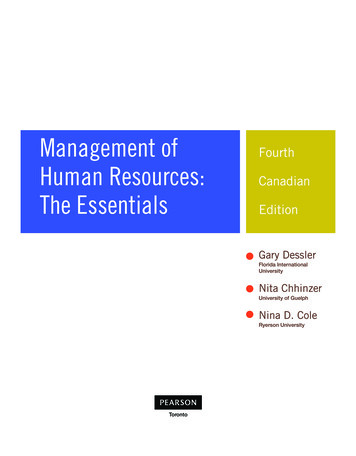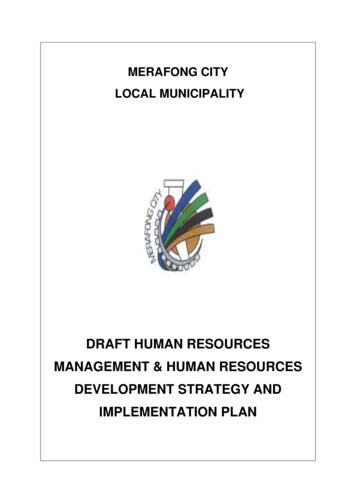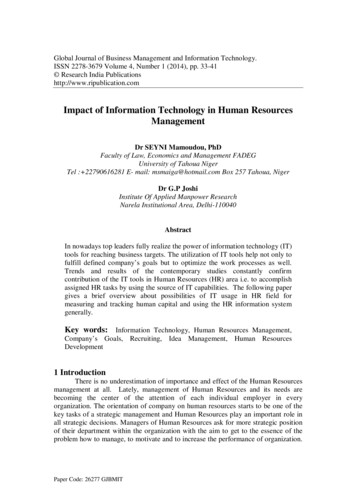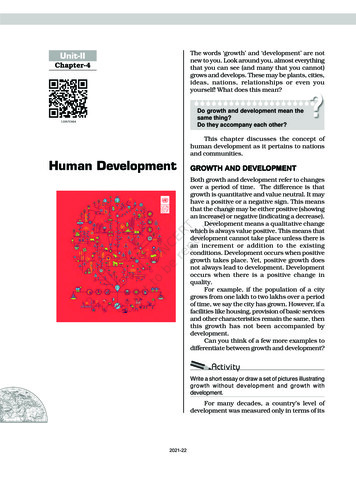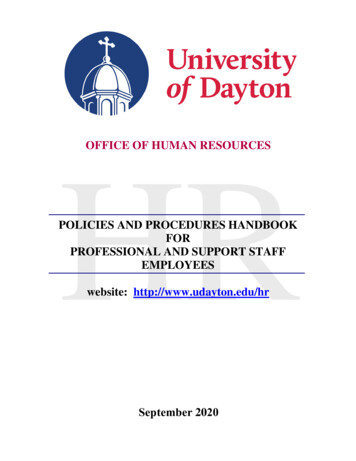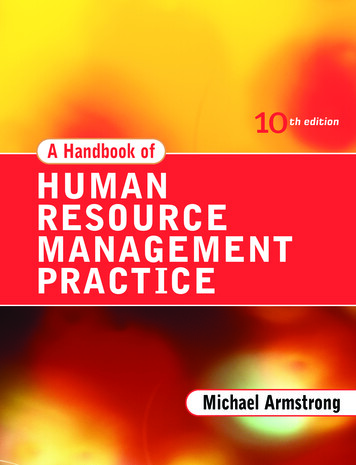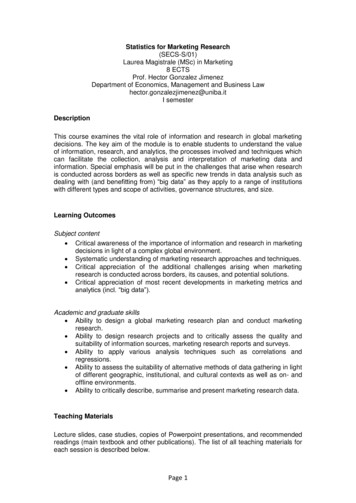
Transcription
Statistics for Marketing Research(SECS-S/01)Laurea Magistrale (MSc) in Marketing8 ECTSProf. Hector Gonzalez JimenezDepartment of Economics, Management and Business Lawhector.gonzalezjimenez@uniba.itI semesterDescriptionThis course examines the vital role of information and research in global marketingdecisions. The key aim of the module is to enable students to understand the valueof information, research, and analytics, the processes involved and techniques whichcan facilitate the collection, analysis and interpretation of marketing data andinformation. Special emphasis will be put in the challenges that arise when researchis conducted across borders as well as specific new trends in data analysis such asdealing with (and benefitting from) “big data” as they apply to a range of institutionswith different types and scope of activities, governance structures, and size.Learning OutcomesSubject content Critical awareness of the importance of information and research in marketingdecisions in light of a complex global environment. Systematic understanding of marketing research approaches and techniques. Critical appreciation of the additional challenges arising when marketingresearch is conducted across borders, its causes, and potential solutions. Critical appreciation of most recent developments in marketing metrics andanalytics (incl. “big data”).Academic and graduate skills Ability to design a global marketing research plan and conduct marketingresearch. Ability to design research projects and to critically assess the quality andsuitability of information sources, marketing research reports and surveys. Ability to apply various analysis techniques such as correlations andregressions. Ability to assess the suitability of alternative methods of data gathering in lightof different geographic, institutional, and cultural contexts as well as on- andoffline environments. Ability to critically describe, summarise and present marketing research data.Teaching MaterialsLecture slides, case studies, copies of Powerpoint presentations, and recommendedreadings (main textbook and other publications). The list of all teaching materials foreach session is described below.Page 1
The main text book recommended for this course is:Craig, C.S. and Douglas, S.P. (2005). International Marketing Research. 3rd ed.Chichester: John Wiley & Sons Ltd.Electronic resourcesThe course syllabus, lecture notes, and other information relating to the module areavailable on the e-learning platform.Useful additional reading is likely to be found in journals such as: Journal of Marketing European Journal of Marketing Harvard Business review Industrial Marketing Management International Journal of Market Research International Journal of Research in Marketing International Marketing Review Journal of Advertising Research Journal of Digital Marketing Journal of Interactive Marketing Journal of International Marketing Journal of Marketing Management Journal of Marketing Research Journal of Product and Brand ManagementOther useful resources for working on the assignments:Examples of resources which you can access are:Proquest newspapersAcademic Journal ArticlesFortune Global 500BBC NewsCountry InformationIndustry ReportsCountry ReportsAbout the European UnionThe Department of Trade andIndustry, UKThe United NationsInternational Forum on GlobalizationThe World Trade OrganisationThe World Bank Group:International Monetary Fund:Academic Journal Articles: Indexes& Business Source al information/countries/Industry Reports in Business Source ropa.eu.int/index wto.orgwww.worldbank.orgwww.imf.orgEbsco Business Source PremierWeb of Science: Social Sciences CitationPage 2
The EconomistIndexJSTORScience Directhttp://www.economist.comAssessment methodsClass attendance and participation is strongly encouraged and will condition thestudent’s results in terms of grading.Attending students:Class Attendance and participationProject work (Group)Final Exam20%30%50%Non-attending studentsFinal Exam (written and oral)100%Final ExamThe final exam will consist in a combination of multiple-choice questions, to evaluateconcept retention and open-end questions to evaluate concept management andapplication. In order to guarantee an objective evaluation, closed rubrics will beapplied to open-end questions.The final exam will last 90 minutes.Project workStudents will engage in group work on an assigned task and give a presentation oftheir findings. The work will be evaluated in terms of research proficiency, content,and overall presentation skills. Groups will be composed of 3-4 students.Page 3
Timetable – Statistics for Marketing Research (Fall 2018)Convenor: Dr. Hector Gonzalez JimenezSTART OF TERMSession 1Session 2Session 3Session 4Session 5Session 6The role of marketing research: a global perspective Primaryand secondary data Introductions and course outline The research process – Global considerations Research Objective vs. Marketing Objective Exercise Primary and secondary data characteristicsLecture: Primary and secondary data continued Interpreting a secondary data market analysis on the UKmobile market (Mintel report) Scenario exercise: European sandwich company in China Accessing and interpreting free data (e.g., World Bank data,census data)Lecture: Secondary data continued (Mintel report) Quantitativeresearch: Applications and methods Main survey methods Exercise - cross cultural marketing mistakes Measurement and scaling for questionnairesLecture: Sampling and survey design Questionnaire design process Exercise: Question design Sampling process Survey design tools (i.e. Google survey) Exercise: Survey designLecture: Data analysis Preliminary data analysis (data cleaning, coding, formatting) Descriptive statistics Correlational analysis and regressions ANOVA and MANOVALecture: Qualitative research - Applications and methods Overview, pros and cons of qualitative research methodsPage 4
Session 7Session 8 Examples of projective techniques Mood board creation and presentationLecture: Focus groups and in-depth interviews Exercise: Two short focus group simulations Focus group analysis and presentationLecture: Observation and mystery shopping Session 9Session 10Lecture: Mystery Shopping cont. Big data in marketingresearch Presentation mystery shopping findings Exercise: Big data – How you interact daily with Big DataLecture: Reporting marketing research EXAM Due date tobe released afterstart of termExercise: Mystery shopping report preparation and actualmystery shoppingSummary of course and open question sessionFinal ExamPage 5
Lecture OutlineSession 1 - The role of marketing research: a global perspectiveSUMMARY:This session sets the stage for the whole course. As firms increasingly expand operationsin countries beyond their home market, they require marketing research to guide theirdecision making to serve consumer needs. However, political, cultural, social andeconomic forces sometimes require researchers to make adjustments to their researchapproach depending on their target market. Hence, marketing research is more importantand challenging now than it ever has been. To be successful, marketing researchers needto understand and select the appropriate research methods (e.g. survey, focus groups) thatwill satisfy the aims of the research project, while accounting for potential challenges thatmay arise due to marketplace differences. For instance, research projects might explorewhether a company should standardize strategies across countries as opposed to adaptingthese to local market differences.LEARNING OBJECTIVES: What is marketing research and why do we need it? How does the marketing research process look like? Which potential research challenges can arise in the global marketplace? International marketing blunders due to “bad” research; what to avoid. Differentiate between marketing strategy and marketing research objectives. Understand the differences between primary and secondary research.KEY READINGSCraig, C.S. and Douglas, S.P. (2005). International Marketing Research. 3rd ed.Chichester: John Wiley & Sons Ltd.ADDITIONAL READINGSS. P Douglas, and C.S. Craig (2011), ‘Convergence and divergence: developing asemiglobal marketing strategy’, Journal of International Marketing, 19 (1), 82-101.C. Samuel Craig and Susan P. Douglas (2001), ‘Conducting international marketingresearch in the twenty‐first century’, International Marketing Review, 18 (1), 80 – 90.Session 2 – Primary and secondary dataSUMMARY:This session looks at secondary data. A variety of data sources can aid researchers in theirdecision making. Secondary data is often readily available, but issues of comparability fromone country to another, as well as its reliability and appropriateness for the specificresearch problem need to be considered. The session offers a practical overview onvarious secondary data sources. Various exercises are used to learn how to find, interpretsecondary data and ultimately, how this data can be used to inform decision making.Page 6
LEARNING OBJECTIVES: Accessing secondary data sources. The ability to interpret a market research report (e.g. Mintel). Using secondary data to develop a strategy for a new business venture What potential challenges can market researchers encounter? Where to find solid and free secondary data.KEY READINGSCraig, C.S. and Douglas, S.P. (2005). International Marketing Research. 3rd ed.Chichester: John Wiley & Sons Ltd.ADDITIONAL READINGSSmith, E. (2008), ‘Pitfalls and promises: The use of secondary data analysis in educationalResearch’, British Journal of Educational Studies, 56 (3), 323–339.Robert L. Harrison and Timothy M. Reilly (2011), ‘Mixed methods designs in marketingresearch’, Qualitative Market Research: An International Journal, 14 (1), 7 – 26.Session 3 - Secondary data continued (Mintel Case) Quantitative research:Applications and methodsSUMMARY:This session focuses on quantitative research. Quantitative research uses a sample of thepopulation to test relationships between variables that offer insights on behaviour,motivations, or attitudes. Researchers generally use statistical techniques to analysequantitative data (e.g. regressions, structural equation modelling, etc.). The sessiondiscusses the nature and rationale behind the use of quantitative research. In addition, thesession offers a brief outline of the main quantitative research methods used byresearchers. Examples of research questions/problems that can be addressed withquantitative research are also offered. Moreover, the session introduces potentialchallenges of conducting quantitative research in a global setting.The session also defines the meaning of measurement and scaling and introduces varioustypes of measurement scales. Next, it describes what a construct is and offers examples ofscales on how different constructs are measured (e.g. brand attitude, cosmopolitanism).Differences between single and multi-item scales as well as how to assess the reliabilityand validity of a measurement instrument are discussed.LEARNING OBJECTIVES: What is quantitative research? What are the main quantitative research methods and analysis techniques used? When is each method appropriate? What are some potential challenges of conducting quantitative research in a globalsetting? What is the importance of having adequate measures and scales in marketingresearch? What type of scales can be used to measure a construct? How to assess if the measurement instrument is reliable and valid?Page 7
What do researchers have to consider when measuring data in more than onecountry?KEY READINGSCraig, C.S. and Douglas, S.P. (2005). International Marketing Research. 3rd ed.Chichester: John Wiley & Sons Ltd.ADDITIONAL READINGSAric Rindfleisch, Alan J. Malter, Shankar Ganesan, Christine Moorman (2008), ‘CrossSectional Versus Longitudinal Survey Research: Concepts, Findings, and Guidelines’,Journal of Marketing Research: June 2008, 45, (3), 261-279.Hanson, DJ and Grimmer, MR (2007), ‘The mix of qualitative and quantitative research inmajor marketing journals, 1993-2002’, European Journal of Marketing, 41 (1/2), 58-70.Van de Vijver FJR, Leung K. (2000), ’Methodological issues in psychological research onculture’, Journal Cross-Cultural Psychology, 31, 33–51.Session 4 – Sampling and survey designSUMMARY:This session discusses survey research and the design of a questionnaire. Surveyresearch involves typically structured data collection techniques, is based on large samplesizes and uses a questionnaire as research instrument. The design of a questionnaireentails issues such content specification, question formulation and sequencing. In marketresearch it is of particular importance to ensure that the research instrument is adapted tothe specific national and cultural environment, hence limiting any potential bias. Bias canoccur due to translation or scoring issues, social desirability, as well as inconsistencies inthe administration process. Therefore, researchers need to take the necessary precautionswhen designing and administrating a questionnaire.Once the questionnaire has been designed, the next step is to develop appropriatesampling and data collection procedure. A variety of random and non-random samplingprocedures are available to researchers. The key is to select a systematic samplingprocedure to ensure that reliable and comparable data are collected which adequatelyreflect the sample population and provide valuable insights with regard to the researchquestion.This session focuses on the questionnaire design process. It discusses different questiontypes and the risks associated with inadequate question formulation (e.g. leadingquestions). The pros and cons of various methods on how to administer a questionnaireare presented. Next, sources of potential bias during the research process are discussed.The session also addresses the sampling process and provides guidelines on how toselect the appropriate sampling approach for a project. Finally, the students design asample questionnaire with an online survey design tool.LEARNING OBJECTIVES: How to design a questionnaire? What type of questions should be used to address a specific research question? How to administer the questionnaire?Page 8
Which potential sources of bias exist in global market research?What sampling approaches are available to researchers?How to use a survey design tool to create a basic questionnaire.KEY READINGSCraig, C.S. and Douglas, S.P. (2005). International Marketing Research. 3rd ed.Chichester: John Wiley & Sons Ltd.ADDITIONAL READINGSSchwarz, N. (2003), ‘Self-reports in Consumer Research: The Challenge of ComparingCohorts andCultures’, Journal of Consumer Research, 29(4), 588–594.Lietz, P. (2010), ‘Research into questionnaire design – a summary of the literature’,International Journal of Market Research, 52(2), 249-272.Deutskens, Elisabeth, de Ruyter, Ko, Wetzels, Martin, and Oosterveld, Paul (2004),‘Response Rate and Response Quality of Internet-Based Surveys: An Experimental Study’,Marketing Letters 15(1):21-36.Hans Baumgartner, Jan-Benedict E.M. Steenkamp (2001), ‘Response Styles in MarketingResearch: A Cross-National Investigation,’ Journal of Marketing Research, 38, (2), 143156.Hester van Herk, Ype H. Poortinga, Theo M.M. Verhallen (2005), ‘Equivalence of surveydata: relevance for international marketing", European Journal of Marketing, 39 (3/4), 351– 364.Jan-Benedict E.M. Steenkamp, Martijn G. de Jong, Hans Baumgartner (2010), ‘SociallyDesirable Response Tendencies in Survey Research’, Journal of Marketing Research, 47(2), 199-214.Podsakoff, Philip M.; MacKenzie, Scott B.; Lee, Jeong-Yeon; Podsakoff, Nathan P. (2003),‘Common method biases in behavioral research: A critical review of the literature andrecommended remedies’, Journal of Applied Psychology, 88(5), 879-903.Shintaro Okazaki, Barbara Mueller (2007), ‘Cross‐cultural advertising research: where wehave been and where we need to go’, International Marketing Review, 24 (5), 499 – 518.Session 5 – Data analysisThis session focuses on the process of data analysis. Once quantitative data has beencollected, or made available through secondary research, it is time to run a data analysis.Generally, before the data can be analysed, it needs to go through various preliminaryprocedures such as cleaning, formatting and coding. There are a variety of data analysismethods and tools available to researchers. This session will focus on the arguably morecommonly used types of analysis methods applied by researchers in business settings.Specifically, after discussing and practicing the preliminary procedures, students will beable to deal with a sample data set to extract descriptive statistics, as well as runningcorrelation analysis and regressions. Moreover, the session will also cover ANOVA andMANOVA tests. These methods allow researchers to assess, for instance, how individualcharacteristics are related to specific brand perceptions or which drivers may influencemore strongly a consumer’s brand attitude.Page 9
LEARNING OBJECTIVES: How to prepare data for data analysis. How to run descriptive statistics. How to conduct and interpret correlational analysis. How to run and interpret a regression analysis. How to conduct ANOVA and MANOVA tests.Note: Students will use Excel as the main tool. Depending on time there will also be asample demonstration of SPSS as an alternative analysis tool.Readings and supporting materials: Craig, C.S. and Douglas, S.P. (2005). International Marketing Research. 3rd ed.Chichester: John Wiley & Sons Ltd. Document with links to instructional videos on data analysis Field, A. (2013). Discovering Statistics using IBM SPSS Statistics. 4th ed. London:SAGE publications.Session 6 – Qualitative research: Applications and methodsThis session deals with qualitative research. Qualitative research aims to acquire an indepth understanding of behaviour and its underlying reasons. It allows uncovering andexploring a consumer’s subconscious feelings and needs that influence their purchasingdecisions. Qualitative research offers researchers a means to answer questions on the‘how’ and ‘why’ of a consumer’s decision making. Qualitative research methods includeobservations, focus groups and in-depth interviews. These methods are used in anexploratory manner and are generally based on smaller samples compared to quantitativeresearch. For instance, qualitative methods are used to formulate and define researchquestions and hypotheses more clearly. Qualitative research methods are also used topre-test advertisements, product packaging or to probe and explore deeply consumerattitudes towards a brand.The session addresses the nature and rationale behind the use of qualitative research. Inaddition, the session offers a brief outline of the main qualitative research methods used byresearchers (full lectures will be dedicated to offer more detail on each of the mainqualitative methods). Some examples of when to apply observations, focus groups or indepth interviews are also provided. Moreover, the session discusses the potentialchallenges of conducting qualitative research in a global context. In addition, students willbe exposed and practice various projective techniques that can be used in qualitativeresearch. This includes the creation of a mood board on a selected brand and subsequentshort interpretation and presentation of the mood board.LEARNING OBJECTIVES: What is qualitative research? What are the main qualitative research methods? When are these methods appropriate? What are the challenges of conducting qualitative research across borders? The use of projective techniques in qualitative research.Page 10
KEY READINGSCraig, C.S. and Douglas, S.P. (2005). International Marketing Research. 3rd ed.Chichester: John Wiley & Sons Ltd.ADDITIONAL READINGSHanson, DJ and Grimmer, MR (2007), ‘The mix of qualitative and quantitative research inmajor marketing journals, 1993-2002’, European Journal of Marketing, 41 (1/2), 58-70.Birkinshaw, J., Brannen, M. Y., & Tung, R. L. (2011), ‘From a distance and generalizable toup close and grounded: Reclaiming a place for qualitative methods in internationalbusiness research’, Journal of International Business Studies, 42(5), 573–581.Doz, Yves L. (2011), ‘Qualitative research for international business’, Journal ofInternational Business Studies, Vol. 42 (5), 582–59.Session 7 – Focus groups and in-depth interviewsSUMMARY:This session focuses on two important qualitative research methods. Specifically, (1) focusgroups and (2) in-depth interviews. First, a focus group is a research method that collectsdata through group interaction (around 8-10 people) on a specific topic. They can be verystructured or unstructured depending on the research purpose and are generallymoderated by an experienced researcher. Second, in-depth interviews (IDI’s) are incontrast to focus groups based on the interaction of just one individual and the researcher.They are often extensive interviews in which the respondent is encouraged to talk andshare his opinion on a specific topic (e.g. consumption of diet products). IDI’s can bestructured and unstructured and are sometimes used to discuss sensitive topics, whichwould not be discussed as freely in a group environment.The session discusses the nature and applicability of each of the two methods. Examplesof research questions/problems that can be addressed with each method are also offered.The recruitment process, research process and analysis procedures are also discussed.The session also addresses the pros and cons of each method as well as potentialchallenges that can arise at a global and local level. The session also uses a practicalapproach through a focus group simulation, followed by an analysis and presentation of thefocus group findings.LEARNING OBJECTIVES: What are focus groups and in-depth interviews? When should each method be applied? What are the pros and cons of each method and what potential challenges do theyentail? How to run, analyse and interpret a focus group.KEY READINGSCraig, C.S. and Douglas, S.P. (2005). International Marketing Research. 3rd ed.Chichester: John Wiley & Sons Ltd.Page 11
ADDITIONAL READINGSBrecic, R., Filipovic, J., Gorton, M., Galjina, O., Stojanovic, Z., & White, J. (2013), ‘Aqualitative approach to understanding brand image in an international context’,International Marketing Review, 30 (4), 275-96.Boote, J. and Mathews, A. (1999), ‘Saying is one thing; doing is another: the role ofobservation in marketing research’, Qualitative Market Research: An International Journal,2 (1), 15-21.Evert Gummesson, (2005), ‘Qualitative research in marketing: Road‐map for a wildernessof complexity and unpredictability’, European Journal of Marketing, 39 (3/4), 309 – 327.Session 8 – Observation and mystery shoppingSUMMARY:This session discusses two further qualitative methods; namely, observations and mysteryshopping. First, with observational methods the researcher relies on what s/he can observe togather insights rather than communicating with the respondents. Observational methods areapplicable when a phenomenon is easily observable (e.g. shopping behaviour), thephenomenon occurs at a subconscious level, and consumers are unable or unwilling tocommunicate directly with the researcher. Moreover, besides observations, the session alsodiscusses the mystery shopping process. Mystery shopping is commonly applied in theservice and retail industry in order to assess, for instance, customer service levels. Forinstance, a researcher visits disguised as a customer a hotel or supermarket to evaluate theservice standards of the venue and its staff and consequently prepares a report for the client.Student’s will be asked to engage in mystery shopping at a local business.LEARNING OBJECTIVES: What are observational methods and mystery shopping? When should each method be applied? What are the pros and cons of each method and what potential challenges do theyentail? How to run, analyse and interpret a mystery shopping experience.KEY READINGSCraig, C.S. and Douglas, S.P. (2005). International Marketing Research. 3rd ed.Chichester: John Wiley & Sons Ltd.ADDITIONAL READINGSFinn, Adam, & Kayande, Ujwal. (1999). Unmasking a phantom: A psychometric assessmentof mystery shopping. Journal of Retailing, 75(Summer), 195–215.Hudson, Simon, Tim Snaith, Graham A. Miller, and Paul Hudson (2001). “DistributionChannels in the Travel Industry: Using Mystery Shoppers to Understand the Influence ofTravel Agency Recommendations.” Journal of Travel Research, 40 (2): 148-154.Page 12
Sinha, P.K. and D.P. Uniyal (2005). “Using Observational Research for BehaviouralSegmentation of Shoppers,” Journal of Retailing and Consumer Services, 12 35–48.Session 9 – Mystery Shopping cont. Big data in marketing researchFirst, the session starts with the student’s mystery shopping presentations. Subsequently, thissession addresses the role of “big data” in market research. The last decade has seen anexponential growth of data streams due to the use of technology across industries andapplications. For instance, extensive data sets are generated by consumers using the internetand in particular social media. Moreover, new types of data are also generated through theuse of digital sensors in machines, automobiles, or even buildings. These sensors measureand communicate the location, frequency, interactions and behavioural patterns of individuals.The result is a vast stream of data that offers researchers and strategists a new approach tounderstanding the world and making decisions.This session focuses on explaining what big data means and its rise in popularity as aninformation source. The sources of big data and applications for business practitioners as wellas academics are presented. Specifically, the session discusses how most of us are involvedin generating data through our daily behaviour. How big data is applied, managed andanalysed is also addressed. The session also includes a practical exercise where studentsevaluate and present how Big Data affects their daily life.LEARNING OBJECTIVES: What is big data? How is big data being generated? Who can benefit from big data? What type of information can marketing researchers gather from big data? How does big data affect your daily life?KEY READINGSCraig, C.S. and Douglas, S.P. (2005). International Marketing Research. 3rd ed.Chichester: John Wiley & Sons Ltd.ADDITIONAL READINGSChen, H., Chiang, R.H.L., and Storey, V.C. (2012), ‘Business intelligence and analytics: frombig data to big impact,’ MIS Quarterly, 36 (4), 1165-1188.Davenport, T, Paul B and Randy B (2012), ‘How 'Big Data' is different,’ MIT SloanManagement Review, 54 (1),Page 13
Session 10 – Reporting marketing research and course summaryAdequate reporting is essential to communicate research findings in a clear and effectivemanner. This session will provide guidelines on how to structure a professional researchreport. The session will discuss appropriate reporting. Moreover, the session will also focuson how to prepare a clear and concise executive summary of a research report, as this is anessential component of a report especially valued by senior level management.In addition, the content of the final session will be determined based on the needs andinterests of the students. For instance, the session could focus on discussing specific analysistools, a summary of the course, or a revision of specific course materials.Class EtiquettePlease turn off or silence mobile phones before class. Students involved in ongoingconversations, texting and/or answering cell phones during class time will be askedto leave without warning!Cheating and PlagiarismCheating and plagiarism are serious offenses. Cheating is the attempted orunauthorized use of materials, information, notes, study aids, devices orcommunication during an academic exercise.Examples include but are not limited to: Copying from another student during an examination or allowing another to copyyour work Unauthorized collaborating on a take home assignment or examination Using unauthorized notes during a closed book examination Using unauthorized electronic devices during an examination Taking an examination for another student or asking or allowing another studentto take an examination for you Submitting substantial portions of the same paper to two classes withoutconsulting the second instructor Allowing others to research and write assigned papers including the use ofcommercial term paper services Signing for another student on the attendance sheetPlagiarism is the act of presenting another person’s ideas, research or writing as yourown: Copying another person’s actual words without the use of quotation marks andfootnotes (a functional limit is four or more words taken from the work of another). Presenting another person’s ideas or theories in your own words withoutacknowledging them. Using information that is not considered common knowledge withoutacknowledging the source. Failure to acknowledge collaborators on homework and laboratory assignmentMy policy is to give a failing grade to any assignment that has been plagiarized or anexam in which you have cheated. If I catch a person cheating on the attendancesheet my policy is to give a zero to the cheating student for his/her attendance grade.Page 14
Page 15
Differentiate between marketing strategy and marketing research objectives. Understand the differences between primary and secondary research. KEY READINGS . Once the questionnaire has been designed, the next step is to develop appropriate sampling and data collection procedure. A variety of random and non-random sampling
